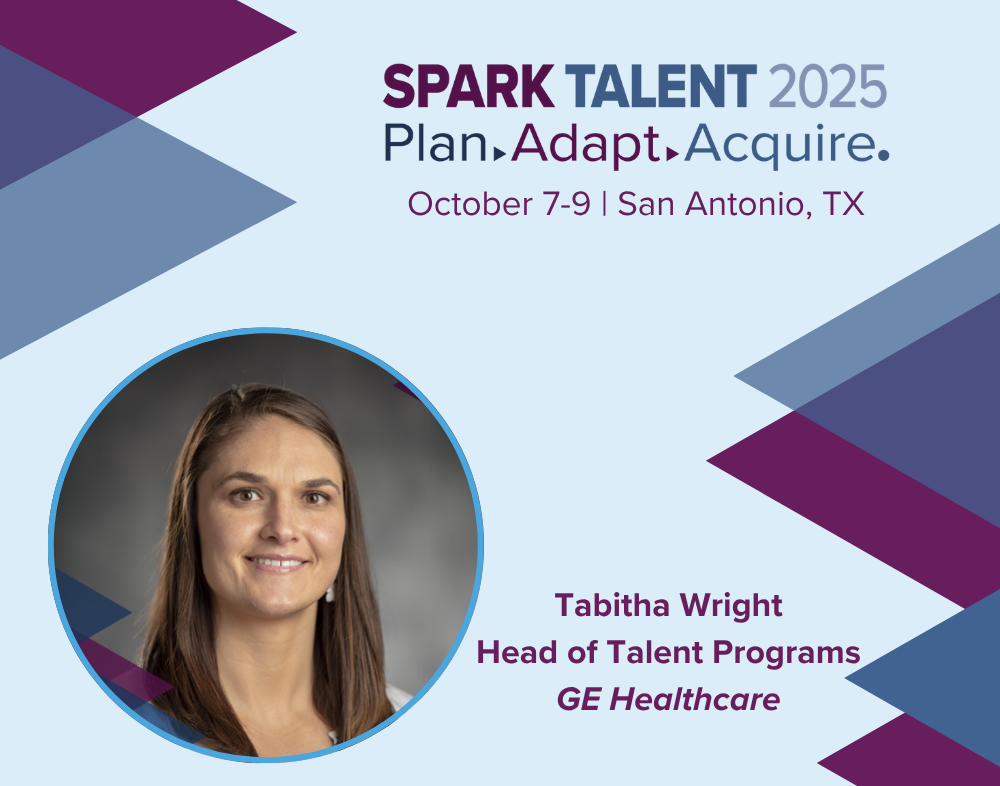GE Healthcare Exec’s 4 Tips on Recruiting Top Talent
Author


It’s easy to look at the HR industry these days and fear for the future of talent. Every new survey and study tells us we’re in an employee engagement crisis, AI is constantly reinventing the workplace, and there is a skills gap between what employers need and what employees possess.
But what if there were ways to not only find the perfect people for your company, but set them on a path to grow into leaders and change makers? Head of Talent Programs for GE Healthcare, Tabitha Wright, is an expert on the matter, and her inventive strategies and passion for growing people have changed the game.
“I’m here to turn workforce gaps into strategic opportunities through data, through partnerships, and really purpose-driven design,” Wright says. “We don’t just fill roles, but we get to build futures by bridging academic, military, even early career pipelines into GE Healthcare care roles. That’s what I think is going to ensure readiness for both today’s challenges and tomorrow’s needs.”
Wright is set to speak at SPARK TALENT 2025 this fall, diving into her expertise and knowledge, and HR Daily Advisor was able to preview her upcoming insights and learn that, with the right strategy, the future of recruiting looks incredibly bright. Here are the 4 biggest takeaways from Tabitha’s talk:
Here are the 4 biggest takeaways from Tabitha’s talk:
Meet Talent Where They’re At: Military & School
The ideal employee isn’t always going to be running around job fairs and handing out fancy business cards. If recruiters want to build strong teams, they’re going to have to “meet talent where they’re at,” Wright says.
She makes special mention of recruiting around military and educational fields—often untapped talent pools—that, when given the right resources, create strong and aspirational employees.
Wright explains, “Meeting talent where they’re at, it means getting on those military bases. It means through nontraditional and traditional academic education partners. This could be launching a military externship that doubles as a national service training. This could be embedding apprentice programs in the local area, or it could even be partnering with these high schools for early talent or experienced talent with veteran-led and veteran-focused colleges.”
Being thorough and creative, as Wright suggests, allows HR to grow talent.
“The key here,” she says, “is building this multi-layered ecosystem that grows talent from the ground up.”
Rehaul the Employee Journey
Improving your employees’ experience and being thorough in your talent pipelines means starting from the beginning and seeing what you can improve. That means tackling one of the most overlooked elements of the employee journey: onboarding.
“Recently, we reimagined and did a whole rehaul of our onboarding program. We turned it into a 12-month learning journey, not just the day, not just a week, not just the checklist,” Wright says. “Because engagement really doesn’t start on day one. It starts long before day one and goes well beyond.”
The change has to start with HR, and there’s no better way to learn how to change than listening.
“We listened very closely,” Wright says, “to feedback from new hires who honestly felt overwhelmed, mentors who needed greater clarity on what their role was, and hiring managers who wanted their new hires ramped up quicker and wanted better visibility to progression. And that’s what became our blueprint.”
Pipelines, Not Funnels
When building pipelines for your talent, HR leaders should prepare for where they need their workforce to be, not where it currently stands.
“If your pipeline doesn’t reflect future work needs, it’s just a funnel, right? We could go out there and build pipelines left and right, but the pipeline always needs to be built with the end in mind,” Wright says. “So here at GE Healthcare, we use real-time dashboards, conversion metrics, and whole lot of feedback loops to ensure that we have quality talent coming through these pipelines.”
Success requires a lot of foresight, but you don’t have to go it alone. The more team members you involve in the pipeline process the better the result, as Wright explains:
“The key for me has been embedding these hiring managers and mentors and technical experts into the program designed from the get-go. We didn’t want to build these talent pipelines in a vacuum, and this is what really ensures that our candidates are trained for real-world readiness.”
Living Strategies Are Key
The crux of Wright’s advice centers around the idea of creating an ecosystem for your talent programs. Everything should work in conjunction.
Wright expounds on GE’s military pipeline programs, and the success it’s had. “It’s a workforce strategy where it supports national defense, corporate hiring, and social impact all at once. I think most companies haven’t realized this win-win-win is actually possible.”
Wright’s work has proven finding talent is possible. The workforce is constantly changing, but when HR leaders build adaptable structures and living strategies that actively respond to workforce needs, you’ll find your talent acquisition programs have new life.
“Talent pipelines are not linear. They are ecosystems. And it’s the new hires, the veterans, the managers who bring these programs to life, who really power the success of those programs,” Wright says. “Our strategy works because it’s data-informed, but human-centered.”
If you’re interested in hearing from more experts on HR and Talent, join us live in San Antonio at SPARK TALENT 2025 and get practical strategies focusing on workforce planning, talent acquisition, and AI-driven processes! We’ll have leaders speaking from ADM, PepsiCo, Nutrien, Staples, The Coca-Cola Company, Hyatt Hotels Corporation, and more, with plenty of opportunities to connect with the HR community.
This article is presented in partnership with HR Daily Advisor. HR Query is a Q&A series by HR Daily Advisor that focuses on HR professionals' insights on current HR trends and dives into their personal stories, helping HR peers connect with challenges and opportunities.

Author

